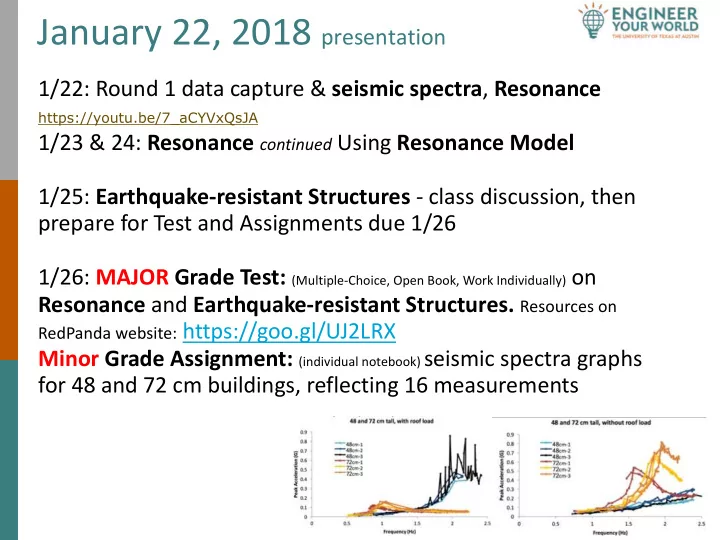

January 22, 2018 presentation 1/22: Round 1 data capture & seismic spectra , Resonance https://youtu.be/7_aCYVxQsJA 1/23 & 24: Resonance continued Using Resonance Model 1/25: Earthquake-resistant Structures - class discussion, then prepare for Test and Assignments due 1/26 1/26: MAJOR Grade Test: (Multiple-Choice, Open Book, Work Individually) on Resonance and Earthquake-resistant Structures. Resources on RedPanda website: https://goo.gl/UJ2LRX Minor Grade Assignment: (individual notebook) seismic spectra graphs for 48 and 72 cm buildings, reflecting 16 measurements
Plot your team’s four seismic spectra on one graph.
Enter your team’s seismic spectra on shared data table. https://goo.gl/Suo6vB https://docs.google.com/spreadsheets/d/1-MwD0i6XFiQCQJAqavTSDcNsYMeqrjebkzvnPC-d4JE/edit?usp=sharing
Combine seismic spectra for all teams.
Why Did We Test the Buildings? q Testing takes time and resources. q Why not just design new buildings right away?
Because… 1. Customers explicitly asked for evidence of building safety. 2. Testing provides baseline data against which you can compare other designs. How else would you determine if a new design is better? Could be worse! 3. Testing taught valuable lessons such as resonance , which is critical quake-resistance structures.
What do the data reveal? How safe is each of these buildings? The high acceleration “humps” on the graph suggest safety problems. Answer: There is resonance near the frequency of the “hump”. Resonance is the tendency of a system to oscillate with greater amplitude at certain frequencies. Structures behave unpredictably around their resonant frequencies, so we want to avoid those! So: We need to do quantify the safety of the buildings by analyzing our test data resonance .
We are concerned about acceleration and displacement. High acceleration à high High displacement à high forces on the building, and on forces on the building, people and objects inside. especially at the base.
Resonance q A building with a high center of mass shaking back and forth is like a tall stick with a mass on the end shaking back and forth. See resonance demo : https:// youtu.b e/7_aCY VxQsJA M = This beam is anchored only on one end – in this case, the bottom. A structure like this is called a cantilever , with a mass load on top .
Before we can design a new building, we must understand resonance. Tacoma Narrows Bridge: https://www.youtube.com/watch?v=qbOjxPCfaFk Engineering simulation: https://www.youtube.com/watch?v=OrqdFxpM_N4
A Model for Resonance As stiffness ( k ) increases, the resonant frequency ( f ) increases, # non-linearly. ! ∝ As height ( H ) increases, ( f ) decreases, $ % & non-linearly. As mass ( M ) increases, ( f ) decreases, non-linearly.
So in terms of our testing of model buildings: The higher the frequency at which the earth shakes, the greater the energy intensity the earthquake produces and thus the greater the force the shaking ground exerts on the buildings. We can use the equation above to predict how much a certain Force will displace x (move away from vertical) a building if we know the stiffness k of that building. So, to minimize the displacement x of a building when it is shaken by an earthquake Force , the building should have as high a stiffness k as practical. x = Force/ k
Thus, the resonant frequency decreases to about 0.7 x of the original when the mass is doubled (2X).
Recommend
More recommend